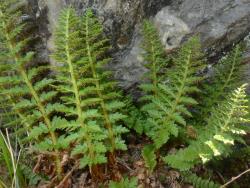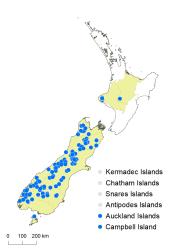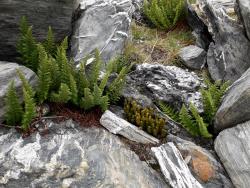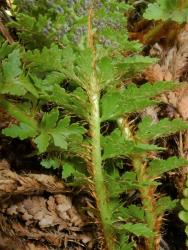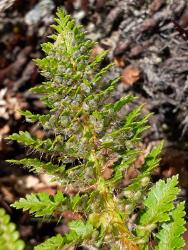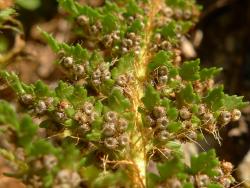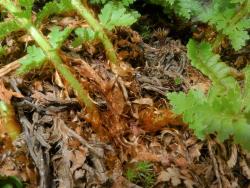- Taxon
- Gallery
- ≡ Aspidium cystostegia Hook., Sp. Fil. 4, 26, t. 227 (1862)
- ≡ Dryopteris cystostegia (Hook.) Kuntze, Revis. Gen. Pl. 2, 813 (1891)
Rhizomes erect, densely scaly. Rhizome scales ovate, 8–28 mm long, 3–8 mm wide, uniformly pale orange-brown, margins entire. Fronds 40–440 mm long, or rarely to 550 mm long. Stipes 5–240 mm long, pale orange-brown, densely scaly proximally but less abundant distally; scales ovate to narrowly ovate, uniformly pale orange-brown, apices acuminate, margins entire. Rachises pale brown, sulcate, narrowly winged only at distal end, abundantly scaly; scales on both surfaces narrowly ovate to linear, pale orange-brown. Laminae 2–3-pinnate, narrowly elliptic, 35–320 mm long, 13–75 mm wide, light green on both surfaces, coriaceous, bearing abundant pale brown scales on abaxial costae and lamina surfaces, sparser on adaxial surfaces. Primary pinnae in 12–27 pairs below pinnatifid apex, overlapping distally, widely spaced proximally, ovate; the longest at or near the middle, 6–42 mm long, 4–27 mm wide, apices acute, bases stalked; costae winged throughout except in largest fronds. Secondary pinnae decreasing in length along the primary pinnae to the distal end; the longest secondary pinnae ovate, 2–18 mm long, 2–10 mm wide, apices acute, margins serrate to deeply divided, bases stalked. Tertiary segments narrowly elliptic, up to 8 mm long and 2 mm wide. Sori round, medial or nearer margin than costa, confined to pinnae in distal half of lamina; indusia round, inflated, 1.0–1.9 mm diameter, ± concolorous, lacking a dark central area.
Polystichum cystostegia is distinguished from all other species in New Zealand by its alpine habitat, large inflated indusia, concolorous orange-brown stipe and rhizome scales, and lack of bulbils. The species is likely to be confused only with P. vestitum, which has bicolorous scales and lacks inflated indusia.
North Island: Volcanic Plateau, Taranaki.
South Island: Western Nelson, Sounds-Nelson, Marlborough, Westland, Canterbury, Otago, Southland, Fiordland.
Stewart Island, Auckland Islands, Campbell Island.
Altitudinal range: 900–2150 m.
In the North Island Polystichum cystostegia is confined to subalpine and alpine areas from c. 900 m to 2150 m on Mt Taranaki and at c. 1630 m on Mt Ruapehu. There is also a single specimen said to have been collected from the vicinity of Judd Ridge in the Tararua Ranges at 600 m in podocarp forest (WELT P025319), a locality which needs confirmation. Cheeseman (1906, 1925) erroneously recorded it from Mt Tongariro, and also cited a collection by Buchanan from the Tararuas, for which there is no extant supporting specimen. In the South Island it extends from north-west Nelson to southern Fiordland, occurring in alpine areas from 900 m, up to 1900 m in the Spencer Range, Nelson. It also occurs on Mt Anglem, Stewart Island, and on the Auckland and Campbell Islands.
Polystichum cystostegia occurs in alpine and subalpine herbfield, tussock grassland, flushes, dry creek beds, rock crevices, among boulders, on rock faces, and among shingle slips in alpine areas, rarely extending into forest at the treeline. It is one of the few truly alpine ferns in New Zealand and occurs at higher altitudes than most other New Zealand pteridophytes.
There is evidence that Polystichum cystostegia hybridises with P. vestitum (Perrie et al. 2003).
n = 82 (Brownlie 1958).
The name Polystichum cystostegia has sometimes been altered to P. cystostegium or even P. cystostigium (e.g. Armstrong 1881), but in the original description Hooker (1862b) treated the specific epithet as a noun in apposition (Art. 23.1), indicated by his spelling of Cystostegia with a capital letter. His original spelling should therefore be retained.



